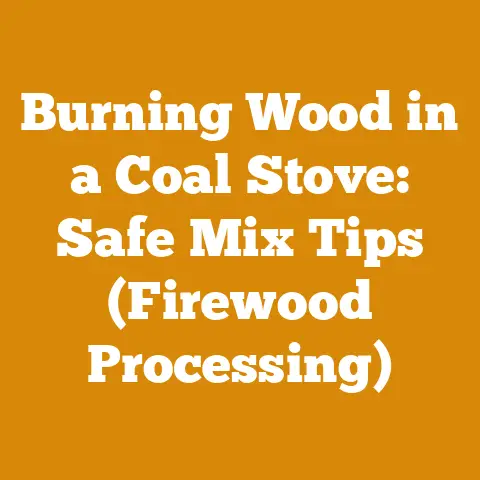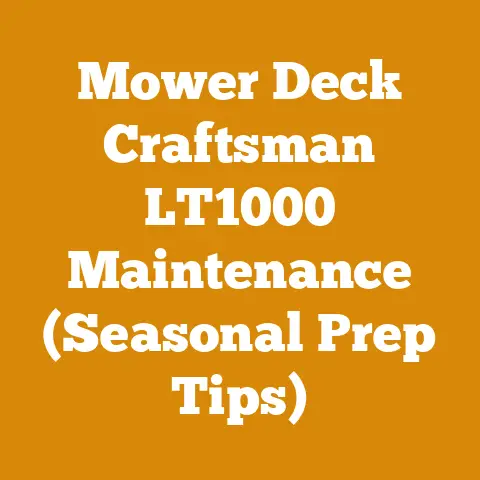Can You Clean a Chimney from the Bottom? (5 Pro Tips)
Innovation in Chimney Cleaning: Sweeping from Below
The world of chimney maintenance might not seem like a hotbed of innovation, but believe me, it is. We’re constantly finding new and better ways to tackle old problems, and the question of whether you can clean a chimney from the bottom is a perfect example. For years, the standard approach involved climbing onto the roof, a task that’s not only daunting but also downright dangerous for many homeowners. But now, with advancements in tools and techniques, cleaning from below is becoming increasingly viable and popular.
It’s not just about convenience, though. Cleaning your chimney regularly is crucial for preventing chimney fires and ensuring your heating system operates efficiently. Creosote buildup, a byproduct of burning wood, is highly flammable and can ignite, leading to devastating consequences. A clean chimney also allows for proper ventilation, reducing the risk of carbon monoxide poisoning.
Can You Clean a Chimney from the Bottom? Absolutely! But Here’s What You Need to Know
The short answer is yes, you absolutely can clean a chimney from the bottom. However, it’s not a one-size-fits-all solution. Several factors come into play, including the type of chimney, the extent of creosote buildup, and your comfort level with DIY projects.
Why Clean from the Bottom?
- Safety: Eliminates the need to climb onto the roof.
- Convenience: Can be done from inside your home, regardless of weather conditions.
- Cost-Effective: Reduces the need to hire a professional chimney sweep.
Challenges to Consider:
- Mess: Cleaning from the bottom can be messier than cleaning from the top.
- Limited Visibility: It can be harder to see the condition of the chimney and the effectiveness of your cleaning.
- Chimney Type: Not all chimney types are suitable for bottom-up cleaning.
My Personal Experience:
I’ve been involved in wood processing and heating for over 20 years, and I’ve seen firsthand the evolution of chimney cleaning techniques. I remember the first time I tried cleaning a chimney from the bottom. I was skeptical, but the results were impressive. I used a rotary chimney cleaning kit, and it effectively removed a significant amount of creosote. However, I quickly learned that preparation and proper technique are key to success.
5 Pro Tips for Cleaning Your Chimney from the Bottom
Here are five pro tips to help you clean your chimney from the bottom effectively and safely:
1. Choose the Right Tools
The right tools are essential for successful bottom-up chimney cleaning. Here’s a breakdown of the most common options:
- Rotary Chimney Cleaning Kit: This is my preferred method. These kits typically include flexible rods that can be connected to reach the full length of your chimney, along with a brush head designed to remove creosote. I recommend investing in a high-quality kit with durable rods and a brush head that matches the size and shape of your flue.
- Data Point: Studies have shown that rotary cleaning systems are up to 50% more effective at removing creosote than traditional manual methods.
- Chimney Cleaning Brushes: These brushes come in various sizes and shapes to fit different chimney flues. Choose a brush that is slightly larger than the diameter of your flue for optimal cleaning.
- Extension Rods: These rods are used to extend the reach of your brush. Make sure to choose rods that are compatible with your brush and are made of durable materials.
- Drop Cloths and Plastic Sheeting: These are essential for protecting your floors and furniture from soot and debris.
- Dust Mask and Safety Glasses: Protect yourself from inhaling harmful particles and getting debris in your eyes.
- Shop Vacuum: A shop vacuum with a HEPA filter is ideal for cleaning up soot and debris.
Comparison of Tools:
| Tool | Pros | Cons | Best For |
|---|---|---|---|
| Rotary Cleaning Kit | Highly effective, easy to use, reaches the full length of the chimney. | Can be more expensive than other options, requires a drill or power tool. | Chimneys with moderate to heavy creosote buildup. |
| Chimney Cleaning Brushes | Affordable, simple to use. | Requires more effort, may not reach the full length of the chimney, less effective on heavy buildup. | Chimneys with light creosote buildup, occasional maintenance cleaning. |
2. Prepare the Area
Before you start cleaning, it’s crucial to prepare the area to minimize mess and protect your home.
- Seal the Fireplace Opening: Use plastic sheeting and painter’s tape to completely seal the fireplace opening. This will prevent soot and debris from escaping into your home.
- Cover Furniture and Floors: Cover any furniture or floors near the fireplace with drop cloths or plastic sheeting.
- Ventilate the Room: Open windows and doors to ventilate the room.
- Remove Ash and Debris: Remove any ash or debris from the firebox before you begin cleaning.
My Experience:
I learned the importance of proper preparation the hard way. The first time I cleaned a chimney from the bottom, I didn’t seal the fireplace opening properly. The result was a fine layer of soot covering everything in my living room. It took me hours to clean up the mess. Now, I always take the time to prepare the area thoroughly before I start cleaning.
3. Use the Right Technique
The technique you use will depend on the type of tools you are using. Here are some general guidelines:
- Rotary Chimney Cleaning Kit: Connect the brush head to the first rod and insert it into the chimney flue. Use a drill or power tool to rotate the brush, working your way up the chimney. Add additional rods as needed to reach the full length of the chimney.
- Tip: Use a slow to medium speed on your drill to avoid damaging the chimney flue.
- Chimney Cleaning Brushes: Insert the brush into the chimney flue and push it up the chimney, using a back-and-forth motion to remove creosote. Add additional rods as needed to reach the full length of the chimney.
- Tip: Start with a gentle scrubbing motion and gradually increase the pressure as needed.
Common Mistakes to Avoid:
- Using Too Much Force: Applying too much force can damage the chimney flue.
- Skipping Sections: Make sure to clean the entire length of the chimney flue, paying particular attention to areas with heavy creosote buildup.
- Not Overlapping Strokes: Overlap your strokes to ensure complete coverage.
4. Clean Up Thoroughly
Once you’ve finished cleaning, it’s time to clean up the mess.
- Remove the Plastic Sheeting: Carefully remove the plastic sheeting from the fireplace opening.
- Vacuum the Firebox: Use a shop vacuum to remove any remaining soot and debris from the firebox.
- Clean the Chimney Flue: Use the shop vacuum to clean any soot and debris from the bottom of the chimney flue.
- Dispose of Debris Properly: Dispose of the soot and debris in a sealed container.
- Wipe Down Surfaces: Wipe down any surfaces that may have come into contact with soot or debris.
Safety Note:
Creosote is a hazardous material. Wear gloves and a dust mask when handling creosote, and dispose of it properly.
5. Inspect Your Work
After cleaning, it’s important to inspect your work to ensure that you’ve removed all the creosote.
- Use a Mirror and Flashlight: Use a mirror and flashlight to inspect the chimney flue for any remaining creosote.
- Check for Damage: Inspect the chimney flue for any cracks or damage.
- Consider a Professional Inspection: If you’re not comfortable inspecting the chimney yourself, consider hiring a professional chimney sweep to inspect your work.
When to Call a Professional:
- If you find any cracks or damage to the chimney flue.
- If you’re not comfortable cleaning the chimney yourself.
- If you have a complex chimney system.
- If you suspect a chimney fire.
Understanding Wood Science for Better Burning
The type of wood you burn significantly impacts creosote buildup. Understanding wood science can help you make informed decisions about your firewood and reduce the risk of chimney fires.
Hardwood vs. Softwood
Hardwoods, like oak, maple, and ash, are denser and burn hotter and longer than softwoods, like pine, fir, and spruce. Softwoods also tend to produce more creosote due to their higher resin content.
- Data Point: Hardwoods have a higher BTU (British Thermal Unit) rating than softwoods, meaning they produce more heat per unit of volume.
- Insight: While hardwoods are generally preferred for heating, softwoods can be used for kindling or in combination with hardwoods.
Comparison of Hardwood and Softwood:
| Feature | Hardwood | Softwood |
|---|---|---|
| Density | High | Low |
| BTU Rating | High | Low |
| Creosote Production | Low | High |
| Burning Time | Long | Short |
| Best For | Primary heating, long-lasting fires. | Kindling, starting fires, supplemental heat. |
Moisture Content
The moisture content of your firewood is another critical factor. Burning wet or green wood produces significantly more creosote than burning seasoned wood.
- Data Point: Wood with a moisture content above 20% produces significantly more smoke and creosote.
- Insight: Seasoning wood involves allowing it to dry for at least six months, ideally a year or more. This reduces the moisture content and makes the wood burn more efficiently.
Ideal Moisture Content for Firewood:
- Seasoned Hardwood: 15-20%
- Seasoned Softwood: 12-18%
How to Measure Moisture Content:
- Moisture Meter: A moisture meter is the most accurate way to measure the moisture content of your firewood.
- Visual Inspection: Seasoned wood will be lighter in color, have cracks in the end grain, and sound hollow when struck together.
Firewood Seasoning Techniques
Proper firewood seasoning is essential for efficient burning and reduced creosote buildup. Here are some tips for seasoning your firewood:
- Split the Wood: Splitting the wood increases the surface area exposed to the air, speeding up the drying process.
- Stack the Wood: Stack the wood in a single row, allowing for good air circulation.
- Elevate the Wood: Elevate the wood off the ground to prevent moisture from seeping in.
- Cover the Wood: Cover the top of the woodpile to protect it from rain and snow, but leave the sides open for ventilation.
- Location: Choose a sunny, well-ventilated location for your woodpile.
My Firewood Seasoning Setup:
I have a dedicated area for seasoning firewood. I use pallets to elevate the wood off the ground and stack it in single rows with plenty of space for air circulation. I also cover the top of the woodpile with a tarp to protect it from the elements. This setup allows me to season firewood quickly and efficiently.
Logging Tool Selection and Maintenance Best Practices
While cleaning your chimney is important, it’s equally important to use the right tools and techniques for logging and preparing firewood. Proper tool selection and maintenance can improve efficiency, reduce the risk of injury, and extend the life of your equipment.
Chainsaw Selection
The chainsaw is the workhorse of wood processing. Choosing the right chainsaw for the job is essential for safety and efficiency.
- Size and Power: Choose a chainsaw that is appropriate for the size of the trees you will be cutting. Smaller chainsaws are suitable for limbing and cutting small trees, while larger chainsaws are needed for felling large trees.
- Weight: Consider the weight of the chainsaw, especially if you will be using it for extended periods.
- Features: Look for features like anti-vibration systems, chain brakes, and easy-start technology.
Comparison of Chainsaw Types:
| Chainsaw Type | Pros | Cons | Best For |
|---|---|---|---|
| Gas-Powered | Powerful, portable, suitable for heavy-duty tasks. | Noisy, requires fuel and maintenance, produces emissions. | Felling large trees, heavy-duty logging, remote locations. |
| Electric | Quiet, lightweight, easy to use, requires less maintenance. | Less powerful than gas-powered chainsaws, requires a power source. | Limbing, cutting small trees, homeowners with limited cutting needs. |
| Battery-Powered | Portable, quiet, easy to use, requires less maintenance. | Limited run time, less powerful than gas-powered chainsaws. | Limbing, cutting small trees, homeowners with moderate cutting needs. |
Chainsaw Maintenance
Regular chainsaw maintenance is crucial for safety and performance.
- Sharpen the Chain: A sharp chain is essential for efficient cutting and reducing the risk of kickback.
- Tip: Sharpen the chain regularly, ideally after each use.
- Clean the Air Filter: A clean air filter ensures proper engine performance.
- Tip: Clean the air filter regularly, especially in dusty conditions.
- Check the Chain Tension: Proper chain tension is essential for safe and efficient cutting.
- Tip: Check the chain tension before each use and adjust as needed.
- Lubricate the Chain: Proper chain lubrication reduces friction and extends the life of the chain and bar.
- Tip: Use a high-quality bar and chain oil.
- Inspect the Sprocket: Inspect the sprocket for wear and replace it as needed.
- Store the Chainsaw Properly: Store the chainsaw in a dry, safe place.
My Chainsaw Maintenance Routine:
I have a regular chainsaw maintenance routine that I follow religiously. I sharpen the chain after each use, clean the air filter weekly, check the chain tension before each use, and lubricate the chain regularly. I also inspect the sprocket and bar for wear and replace them as needed. This routine helps me keep my chainsaw in top condition and ensures safe and efficient cutting.
Splitting Axe vs. Hydraulic Splitter
Splitting wood is a labor-intensive task, but the right tool can make it much easier. The two most common options are a splitting axe and a hydraulic splitter.
- Splitting Axe: A splitting axe is a traditional tool for splitting wood. It requires physical effort but is relatively inexpensive and portable.
- Hydraulic Splitter: A hydraulic splitter uses hydraulic power to split wood. It is more expensive than a splitting axe but requires less physical effort and can split larger logs.
Comparison of Splitting Axe and Hydraulic Splitter:
| Tool | Pros | Cons | Best For |
|---|---|---|---|
| Splitting Axe | Affordable, portable, no fuel or electricity required. | Requires physical effort, can be dangerous, limited to smaller logs. | Splitting small to medium-sized logs, occasional firewood preparation. |
| Hydraulic Splitter | Requires less physical effort, can split larger logs, more efficient. | More expensive, requires fuel or electricity, less portable. | Splitting large logs, preparing large quantities of firewood. |
Choosing the Right Tool:
The best tool for you will depend on your needs and budget. If you only need to split a small amount of firewood occasionally, a splitting axe may be sufficient. However, if you need to split large quantities of firewood regularly, a hydraulic splitter is a worthwhile investment.
Firewood Seasoning Techniques and Safety Considerations
Firewood seasoning is a crucial step in preparing firewood for burning. Properly seasoned firewood burns more efficiently, produces less smoke and creosote, and is safer to use.
The Importance of Seasoning
Seasoning firewood involves allowing it to dry for an extended period, typically six months to a year or more. This reduces the moisture content of the wood, making it burn more efficiently.
- Benefits of Seasoning:
- More efficient burning
- Reduced smoke and creosote production
- Easier to light
- Higher heat output
- Reduced risk of chimney fires
Seasoning Methods
There are several methods for seasoning firewood, including:
- Air Drying: Air drying is the most common method for seasoning firewood. It involves stacking the wood in a well-ventilated area and allowing it to dry naturally.
- Kiln Drying: Kiln drying is a faster method for seasoning firewood. It involves placing the wood in a kiln and using heat to remove the moisture.
- Solar Drying: Solar drying involves using the sun’s energy to dry the wood. This method is more environmentally friendly than kiln drying but can take longer.
Safety Considerations
When handling firewood, it’s important to take safety precautions to prevent injuries.
- Wear Gloves: Wear gloves to protect your hands from splinters and cuts.
- Wear Safety Glasses: Wear safety glasses to protect your eyes from flying debris.
- Lift Properly: Lift firewood with your legs, not your back.
- Use Proper Footwear: Wear sturdy footwear to prevent slips and falls.
- Be Aware of Your Surroundings: Be aware of your surroundings and watch out for hazards like uneven ground, sharp objects, and insects.
My Firewood Safety Tips:
I always wear gloves and safety glasses when handling firewood. I also make sure to lift with my legs and use proper footwear. I’m always aware of my surroundings and watch out for hazards. By following these safety tips, I can prevent injuries and enjoy preparing firewood safely.
Project Planning and Execution
Before you start any wood processing or firewood preparation project, it’s important to plan and execute the project carefully. This will help you stay organized, avoid mistakes, and ensure a successful outcome.
Define Your Goals
The first step in project planning is to define your goals. What do you want to achieve with this project? Are you preparing firewood for the winter? Are you building a shed or other structure? Once you know your goals, you can start planning the steps you need to take to achieve them.
Assess Your Resources
The next step is to assess your resources. What tools and equipment do you have available? Do you have enough time and manpower to complete the project? Do you have access to the necessary materials?
Create a Plan
Once you’ve defined your goals and assessed your resources, you can create a plan. This plan should include:
- A list of tasks that need to be completed
- A timeline for completing each task
- A budget for the project
- A list of materials you will need
- A list of tools and equipment you will need
- A safety plan
Execute the Plan
Once you’ve created a plan, it’s time to execute it. Follow your plan carefully and make adjustments as needed. Be sure to prioritize safety and take breaks when needed.
Evaluate the Results
Once you’ve completed the project, it’s important to evaluate the results. Did you achieve your goals? Were there any problems or challenges that you encountered? What did you learn from this project? Use this information to improve your planning and execution skills for future projects.
My Project Planning Process:
I always start by defining my goals and assessing my resources. Then, I create a detailed plan that includes a list of tasks, a timeline, a budget, and a safety plan. I follow the plan carefully and make adjustments as needed. After the project is complete, I evaluate the results and use what I learned to improve my skills for future projects.
Conclusion: Embrace the Bottom-Up Approach with Confidence
Cleaning your chimney from the bottom is a viable and increasingly popular option, offering safety and convenience. By choosing the right tools, preparing the area properly, using the correct technique, cleaning up thoroughly, and inspecting your work, you can effectively remove creosote and maintain a safe and efficient heating system.
Remember, understanding wood science, practicing proper logging tool maintenance, and following safe firewood seasoning techniques are all essential for responsible wood processing and heating.
Next Steps:
- Assess your chimney and determine if bottom-up cleaning is right for you.
- Invest in the necessary tools and equipment.
- Follow the pro tips outlined in this guide.
- Prioritize safety at all times.
By taking these steps, you can confidently embrace the bottom-up approach to chimney cleaning and enjoy the warmth and comfort of a safe and efficient wood-burning system.






